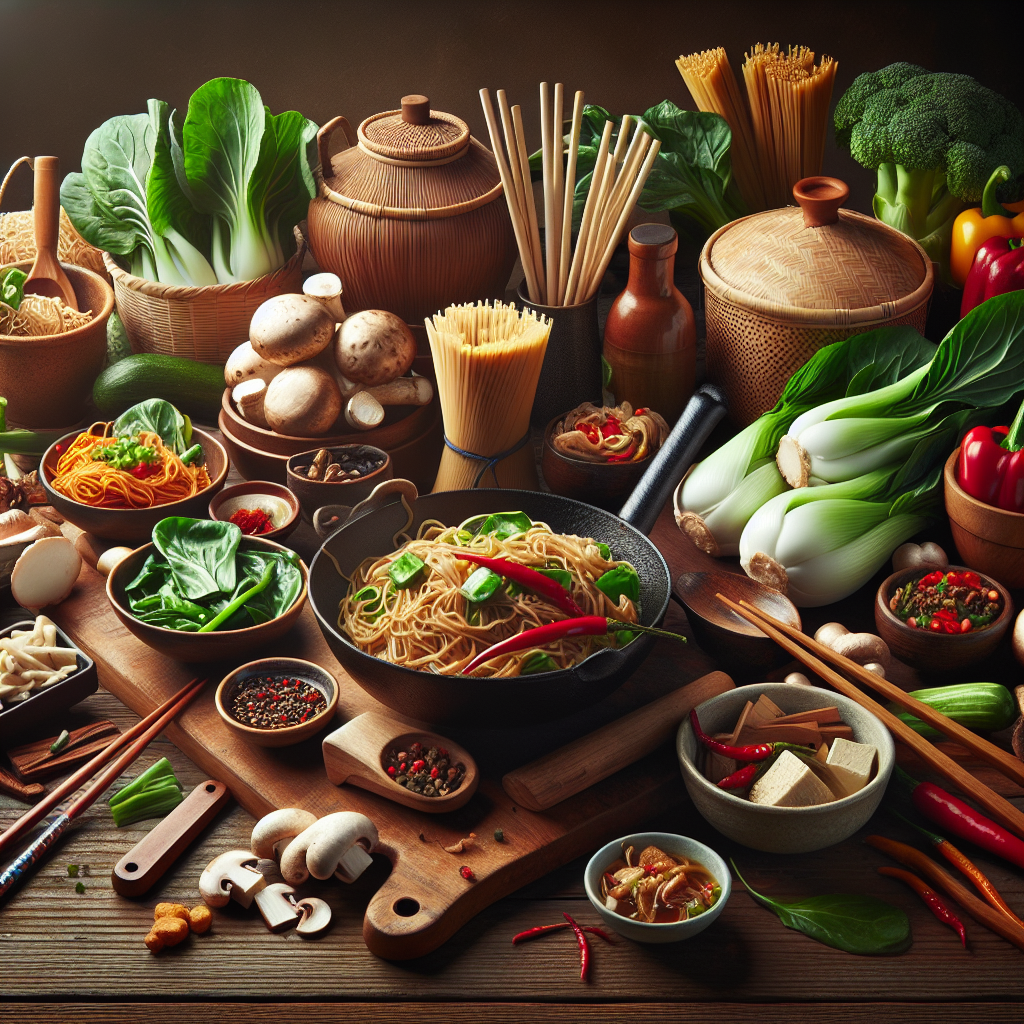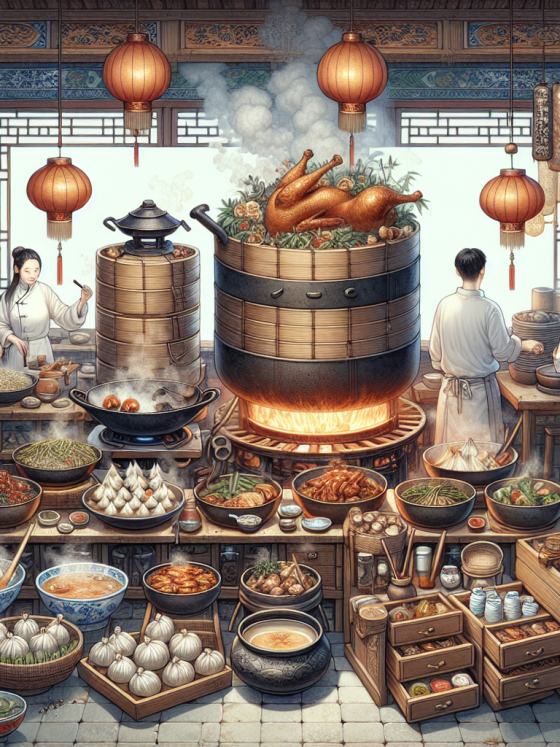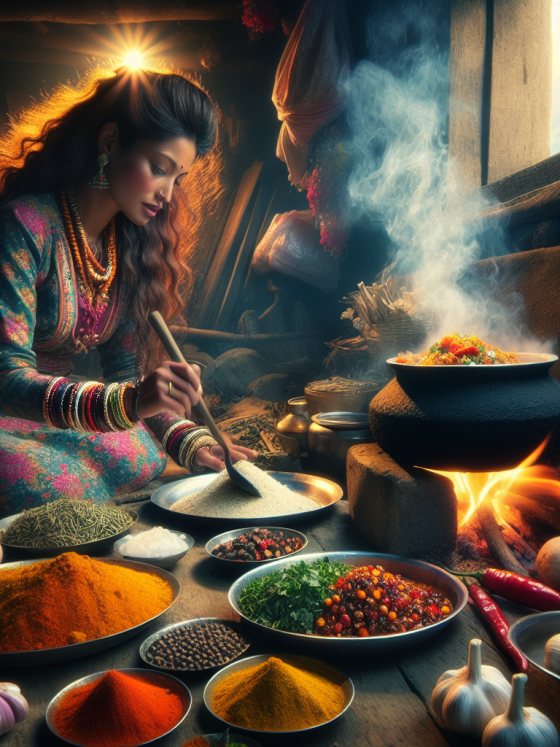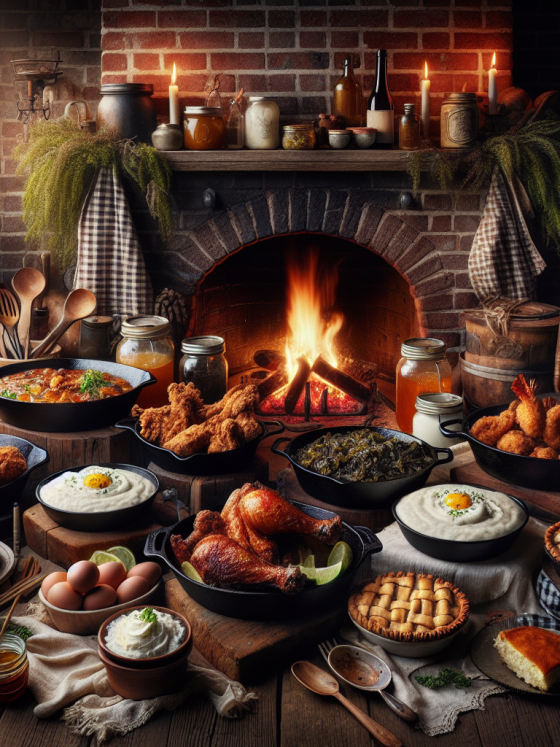Exploring the Flavors and Traditions of the Asian Kitchen

From the fragile shores of Asia comes a vast and varied array of tastes, styles & traditions that make up the tapestry of Asian cooking. Because this is a cuisine that exists at the intersection of history, geography, and culture — all working in tandem to breed its own brand of edible storytelling. The precision, Asian cuisineAs you move from delicate Japanese sushi to a spicy curry of Indian spices and wonderful embers that color every dish in red -Asian is complex. By learning the basics, like the five flavor profiles (sweet, sour salty bitter umami), you can begin to understand why so many Asian dishes have such complex flavors. In addition, the rituals of these traditional dishes – whether in the communal nature Chinese dim sum or respectful manner exhibited during a Thai meal — underscore long-standing practices that carries with it more than just bringing life, but sustenance to friends and family. This walk through the pantry of Asia is not just a trip across different melodic flavours but an experience into the tapestry of culture that knits these culinary gems together.
The Rich Tapestry of Asian Cuisines
The Rich Tapestry of Asian Cuisines paints a brilliant mosaic containing an endless array of culinary traditions across the massive continent. Featuring aromatic street food from Southeast Asia to elaborate feasts of East Asia, each region has a distinct cuisine that is influenced by its history, geography and culture. Even Chinese food encompasses a wide range of unique regional variations — from the heat and spice of Sichuan fare to the subtle flavors found in Cantonese cooking. Whereas Japanese like to savor their sushi, Koreans prefer hearty stews and bold flavors. The diverse gastronomy of India is comprised with different states which contribute a range call spices and cooking methods to the nation’s rich culinary landscape. The foods here in South East Asia, bursts flavors of sweet acidy salty & spicier notes as synonymous to Thailand,Vietnam and Indonesia. These myriad traditions combine to create a culinary landscape that is not only an amazing feast for the senses but also an important reflection of Asia’s cultural and historical heritage.
Diversity Across Regions: East, Southeast, and South Asia
The Asian kitchen is a melting pot of flavors, ingredients and culinary techniques that differ widely from East to Southeast Asia, South Africa. Like China, Japan and Korea also have their own unique variations of dishes alongside a harmony-balanced diet with staples such as rice, noodles, soy products (e.g. tofu) accompanied by sides of fish seasoned with salt or soy sauce miso ingredients similar to fermented sauces/solids including condiments for soups/scrambles eaten during breakfast times.BufferedReader In Southeast Asia, that means spicy and high-flavoured from spice pastes, fresh herbs and a little coconut milk like Thailand,Vietnam or Malaysia. The harmonious notes of sweet, sour, salty and spicy flavors come from ingredients such as lemongrass, galangal (a relative to ginger), turmeric among a variety that is on the long list for secret recipe. One of the major cuisines that exhibits a wide variety of spices, various masalas flavoured curries combined with lentils and appetisers including naan/roti are from South Asia especially India-Pakistan-Sri Lanka. The gastronomic tradition of each area are associated, unique history and geography making a mosaic of tastes that together weave the fabric palate Asian.
Signature Ingredients: Rice, Noodles, Spices, and Herbs
Asian cooking is nothing without its signature ingredients, the secret to giving each dish that comforting yet exotic blend of aromas and flavors. Rice — a common element in Asian food ranges from the aromatic basmati used in India to sticky types essential for Japanese sushi. Another fundamental noodle, it takes many incarnations: the fine rice noodles in Vietnamese pho; or chewy soba noodles for Japanese fare.
Spicing is key, with examples like turmeric, fresh ginger root and Sichuan peppercorns contributing to an array of flavours. Spices not only add flavor, but they can also carry cultural and historical importance sometimes believed to be medicinal. Finally, fresh herbs like cilantro, thai basil and lemongrass add that extra dimension to the dishes — brightening them with liveliness and freshness.
All these components combine to create the foundation of an Asian kitchen rooted in a culinary legacy centered around balance, harmony and appreciation for the wonders that nature has provided us.
Unique Cooking Techniques: Stir-frying, Steaming, and Fermenting
Asian cooking options a mess of distinctive preparation techniques that facilitate structure this various culinary landscape. Stir frying originated in China but similar high-heat, quick cooking methods have preserved the color and texture of ingredients. It calls for a wok greased with just enough oil to keep tiny morsels of food in constant motion, each element imbued with flavor so dynamic that it will rank right up there on the lip-tingle scale and perfectly crisp but not-to-dry — or overly moist.
Steamed food is a healthy way of cooking which means the ingredients are natural and cooked under heat and moisture without being soaked all over in water during boiling. Commonly used steaming methods can be seen applied to various types foods especially from Asian countries. This style preserves nutrients, and intensifies flavors rather than drying them out: its moist texture is a boon for delicate foods such as fish or vegetable dumplings.
Fermenting has deep roots in the culinary traditions of Asia, which is native to its style of preserving food and turning it through natural bacterial processes. It did so well before French chefs started turning cabbage into sauerkraut, and it lives on now in the sulforaphane-rich vegetables served up raw or napped with olive oil to prevent the destruction of cancer-killing compounds that comes when they cross our lips as words (see “Olive Oil: Stealth Fighter-like inhibitor” Sept 2006)—as does a great many living dishes using fermentations designed not just for shelf-life extension but also formed from complex bacterial-derived flavors providing probiotic benefits found throughoutthe Korean kimchi-jarred jars sealed by Japanesemiso stewing Chinese fermented black beans. Collectively, These unique methods embody the essence of Asian cuisine that is so famously rooted in a strict adherence to preserving natural flavors and health effects.
Cultural Significance of Food in Asian Traditions
In Asian traditions, food is not only valued as a source of sustenance and nutrition but also historically rich with influence from religion, history,and social practices. For many of us, meals are more than a necessity for survival — they stand as our cultural heritage and give voice to timeless values. In Chinese cuisine, symbolic ingredients are widely used — for instance long noodles signify longevity in general and fish symbolises prosperity during festivals such as Lunar New Year. Indian food ties in close with religious rituals and Ayurveda — the homeopathic science of balance, harmony. And like the Japanese and in their seasonal aesthetic, reflected in a sense of direct connection to nature. This is in line with the communal dining culture that dominates much of Asian life; where food unites families and hospitality reigns supreme. Family-style dishes, traditional in most Asian families build a bond and sense of belonging. Thus, food leaves the simple concept of feeding and becomes a true cultural expression worth living and handing down from one generation to another.
Food as a Symbol of Hospitality and Community
Food in the Asian kitchen is more than just sustenance; it reflects cultural practices of hospitality and social cohesion. Breaking bread is a simple yet profound offering to embody hospitality and community, demonstrating value in shared connection with family and friends. The cuisines hold together a society, from the intricate process of preparing dim sum in China to superb hot-pot culture in Taiwan. These fine plates highlight the communal act of breaking bread where, every bite is laced in tenderness and love from meticulously whipped dishes dished just to please you. Some ingredients are not only used for the taste but also have a symbolic meaning for example,noodles=called mi sang and symbolizes longevity or fish = called yu and it means Renewed, Prosperous.FirebaseAuth Viewing food this way helps to place it as a cultural practice that can provide an identity, and promote harmony among people which becomes centric when connections grow. The kitchen is thus the embodiment of a pulse that beats to synchronize with other lives and rhythms in order to participate within its system “that works like this” language, whose poetics are found in reciprocal acts of sharing each others tradition hospitality.
Festivals and Celebrations: Lunar New Year, Diwali, and More
In the culinary culture of Asia, festivals and celebrations play a significant role — these are vibrant flavors that cannot be indifferent; it is part of a countries history. Even though the Lunar New Year is celebrated in countries ranging from China to Korea, and Vietnam but often it means a chain of royal feasts. A variety of dishes, some filled with symbolism such as dumplings for wealth or fish to attract a surplus are steeply rooted in tradition. Diwali, a Hindu festival of lights celebrated in India and Nepal features sweet laddus and samosas, the latter which serve as part of everyday meals. Every festival brings the unique eatables that are consumed over there because of geographical diversity and differences in historical trends. In Japan, a Hanami festival to mark the cherry blossom season can see treats like sakura mochi dished out free of charge while in Thailand during Songkran people opt for cooling refreshments such as khao chae. With these celebrations come not just varying flavors of the Asian kitchen but a vessel for cultural expression, unity and an honoring of age-old traditions.
Traditional Dining Etiquette and Practices
It is to be culturally curious about the diversity of culinary tapestry in Asia and one can do that only after exploring its authentic dining etiquette and practices because customs differ but respect among elders as well as community harmony are essentials — similarities across borders. In East Asia, for countries such as Japan and South Korea will say some nice words while they are about to eat things e.g Itadakimasu / Jal meokkesseumnida (Eat well) Be grateful of the plate you have! Use of chopsticks requires its own etiquette: When not in use, place them parallel on a chopstick rest or bowl — never stuck upright into rice as it resembles incense sticks at funerals. In South Asian traditions, predominantly in India, right hand is the auspicious fold for having meals. The sharing of communal dishes reinforces the idea that food is magical because it brings bonds closer and encourages togetherness Eating the elders first, no wastage of food and treasuring every bite are values that cross continents because they have walls drawn around dining not just as an act but as a beautiful experience you nurture.
Iconic Dishes from Different Asian Countries
Asia is a diverse continent and its vast culinary landscape has given us several dishes that speak to the traditional values, history and area of each country. Aromatic curries from Thailand such as Gaeng Keow Wan, the famous Green Curry found in every Thai eatery in modern times brings together a harmony of fresh herbs and coconut milk to give it an earthy kick; while Japan showcases their labourious sushi refining simplicity with utmost quality of produce. And in China, there is the Peking Duck which serves as a mere reminder of complexity and superb taste at once served on delicate pancakes with plum sauce. The creamy butter and tomato-based sauce of India’s Butter Chicken (Murgh Makhani) will make you a life-time fan after the first bite. The Vietnamese Pho, the fragrant noodle soup either made with beef or chicken and lots of broth & fresh herbs. In Korea, meanwhile, Bibimbap is a beautiful blend of any seasoned veggie you want with rice and protein topped with gochujang. All the fares also give a taste of where they come from by showcasing to you what migrant cooks think are typical foods will love eating; so bite into different eats for varied cultural and gastronomical looks at Viet Nam.
Japanese Sushi and Ramen
Japanese food, the magical combination of tradition, accuracy and taste in dishes like sushi or ramen Sushi, a delicacy globally celebrated is that ever-loved dish where it takes priority to what has so little ingredients and never fails to highlight the fresh & raw reinforcements seamlessly moulded with vinegared rice. Nigiri, sashimi and maki are some of the popular styles in which sushi is served to maintain a balance between taste, texture and presentation — making it an elegantly plated dish that went from being a way for fish preservation too culinary art over time. In contrast, ramen — a dense hot noodle soup is one of the ultimate in comfort food for Japan. Hailing from Chinese cuisine, it has evolved in time to suit the taste of Japan into many regional types. Springy noodles, savory broths (shoyu or miso and, of course tonkotsu), marinated soft-boiled eggs and tender chashu pork do so much to dance around your tastebuds creating flavors that communicate comfort. The pair know how to respect natural flavor, an appreciation learned through practice with traditional Japanese umami centric dishes such as sushi and ramen which are simple foods full of the freshest seasonal ingredients.
Chinese Dim Sum and Peking Duck
Highly diverse Chinese cuisine has two of its most popular creations to be Dim Sum and Peking Duck that symbolizes both tradition and culture. Dim Sum, which translates to “touch the heart,” is a variety of small dishes usually served in bamboo steamer baskets or on little plates. An array of dumplings, buns, and rolls packed with different flavors and textures—savory pork and shrimp shumai to sweet custard buns — these bite-sized pieces have delighted generations over cup after cups of tea at Cantonese brunches. Meanwhile, Peking Duck is the penultimate representation of imperial culinary creativity hailing from Beijing. Known for its crispy, golden skin and succulent meat that goes so nicely in those little pancakes with hoisin sauce and scallions. Dim Sum and Peking Duck showcases the delicate skill and sharing ethos inherent to Chinese cookery, showcasing a wealth of knowledge into flavours at one with these Asian kitchen staples.
Indian Curry and Tandoori
Curry and tandoori come from rich tapestry of Indian flavors in foods as vibrant curry. Curry, from the Tamil word “kari” meaning sauce — is a catchall designation for a broad category of foods featuring luxuriously seasoned gravies. Varieties in spices such as turmeric, cumin, coriander and garam masala add complex and odorous tastes to these dishes that differs largely across regions of India. Matching local ingredients with refined culinary heritage, each curry — from the creamy and mildly spiced butter chicken of North India to tangy fish curries cooked in coconut milk (Kerala-style) also narrates a story.
From a cylindrical clay oven called a tandoor, Tandoori cooking gets its name and it comprises marinating meats or paneers and vegetables in yogurt with spices for hours before they are then cooked at high temperatures. This gives it a stoked blaze on the outside and juicy within. Tandoori chicken, with its fiery and tangy flavor (thanks to the red spices in yogurt) is a classic application of this technique. Curry and tandoori may be worlds apart—literally—but they remind us of the creativity, nuance, and flavor-packed world that Indian cooking offers.
Thai Pad Thai and Green Curry
Pad Thai and Green Curry are two of the staple dishes that hold a mirror to this tapestry when it comes to flavors with an exuberant touch — reflecting the vibrance of Thai cuisine. Say It: The all-time favourite Thai export, Padhthai is a delicious stir fried noodle dish combining sweet, sour, salty and umami flavours in one harmonious marriage. Normally it is made of rice noodles and shrimp or chicken, tofu, eggs,sprouts etc. Fresh tamarind paste gives a sour kick, fish sauce provides an umami richness and palm sugar lends sweetness. The honeyed peanuts scattered overtop all provide a last textural foil to crunch on.
The Green Curry, meanwhile — a creamy-subtle but aromatic dish devised from a paste of green chillies, fresh garlic and lemongrass — gave little trouble at all. The coconut milk helps to tame the fire, and soon you are spooning a smooth, spiced sauce over morsels of chicken or beef (or tofu), bamboo shoots, eggplant and Thai basil. Some of these dishes focus on the variety that many ingredients bring to Thai kitchens while others underscore how the Thai palate is a mix of strong and subtle tastes, with each component playing nicely together in between bites.
Korean Kimchi and BBQ
You’ll get to dive into a colourful and delicious dining hall with Korean cuisine as well, featuring favourites like kimchi (fermented cabbage) & BBQ. What is kimchi if not spicy, gut-busting fermented cabbage as ubiquitous in the Korean diet and industrialized cities like Kim?! However, preparation of yam pottage varies greatly by region and family traditions which have been handed down through many generations. It’s got a lot going on with the ferment — garlic, ginger, chilli and fish sauce for starters.getJSONObject. Just as compelling is Korean BBQ, in which people grill marinated meats — usually beef, pork or chicken — at embedded table grills. It encapsulates that communal, interactive dining experience so central to Korean meals. Banchan — the sides accompany BBQ and provide an assortment of flavors and textures to bite with each morsel. Kimchi and Korean BBQ alone largely define the tradition depth and versatility that make up Korea in food form.
The Modern Evolution of Asian Kitchens
The contemporary Asian kitchens are an interesting convergence of the age-old tradition and innovation, changing culinary practices but still maintaining its ethos. Modern FeaturesThe best Asian home kitchens are modern, so look for new technology to help you. setState-of-the-art appliances (induction cooktops; the latest in rice-cooking or other types of specialized electric cookers), high-speed water filtration and a top-notch exhaust system. The features expedite the cooking process besides increasing its accuracy; this, in turn, results into making preparing food easier. In parallel with these technologies, there is a rekindling of interest in traditional craft methods and ingredients like fermentation, artisanal noodles and organically heirloom grains. Thus, we have now modern Asian chefs finding ways to incorporate global influences and creating fusion dishes that still respect the classic flavors which reflect how tastes of society would be set in a highly diverse place due to multicultural interactions. This adaptive revolution provides a powerful culinary narrative whereby centuries-old dishes rub shoulders with playful, modern offerings to enable the Asian kitchen to further stand as a strong and relevant focal point in global gastronomy.
Fusion Cuisine and Global Influence
Fusion cuisine or the global influence is an important part to discover a taste in tradition of Asian kitchen. By mixing components between different cuisines, fusion cuisine displays the variety and spirit of creativity as part of Asian cooking. This method of cooking is generally a confluence of the base Asian ingredients and techniques with elements from other parts, concocting new age fusions. Mashups like the Japanese staple sushi mixed with South American ingredients create a new take on flavors, for example tuna sashimi tacos.
In addition, the influences of globalization have shown that not only are Asian cuisines becoming more enriched by global culinary practices but also makes an influence along. The demand for Asian food around the world has given rise to many new styles which appeal differently while keeping a similar cultural root. Nowadays you find Vietnamese pho, Thai curry and Indian vindaloo fairly ubiquitous staple dishes throughout the Western world. These exchanges highlight not only a global respect and continued adaption of Asian culinary traditions leading them to permeate beyond cultural norms, but also contribute towards the international food synergy.
Vegetarian and Vegan Adaptations
These vegetarian and vegan adoptions of authentic Asian recipes contribute to the rich flavors, traditions in their kitchens accepting plant-based diets. A large part of the cuisine, particularly in many Asian countries and regions is vegetarian friendly by nature with vegetables, tofu and tempeh (tofu’s Indonesian cousin), legumes such as beans making stellar appearances along side common spices like turmeric. Dishes such as Thai green curry (made with coconut milk, a variety of vegetables and tofu) or Vietnamese pho (two words: mushroom broth to replace meat-based stock, amirite?) illustrate the way in which longstanding flavors translate into alternative formats. That’s because traditional Indian cuisine, which features lentil-based dals (daahl or beans), colorful vegetable curries as well as street foods like samosas out-of-hand if it is made using a pure-vegetarian meal. Another neat thing about Japanese cuisine is how umami plays a big role (think miso, seaweed and tofu), which means you can still get that protein hit without opting for animal products. This move towards seasonal ingredients, and whole traditional spices honours heritage while appealing to the health conscious market – promoting freshness and nutrition balance as well as sustainable eating.
Popularity of Asian Street Food
In the modern day and age, with unique flavors everywhere to be tasted globally, Asian street food has risen in popularity too because of its authentic cultural history. Countries like Thailand, Vietnam, India and Japan provide many kinds of street foods which was loved by the gourmet around the world. With the likes of a traditional meal involving Thai pad thai, Vietnamese pho or Indian samosas and Japanese takoyaki or okonmiyaki—these promises not just an amalgamation but also throws in some serious vibes where one can actually take a sip off on their swift lifestyle as they immerse themselves into another culture while savouring these delicious treats. The lively markets and street-side stalls frequently pass from generation to generation, keeping the well-loved taste of family dishes that celebrate local ingredients and methods. This is most popular with a niche of adventurous eaters and travelers looking for more than just something to nosh on. The accessibility and popularity of street food owe a great deal to its affordability and convenience. Its worldwide renown has also translated to urban food scenes across the globe with popular street eats prompting food trucks and pop-up events, as well as higher-end restaurants showcasing an Asian culinary tradition for a wider audience.
So what have we concluded?
In short, a trip through the Asian kitchen is full of flavors and traditional methods that are very different from each other as cultures in most cases. From the umami-rich dishes of Japan and fiery spices of Thailand, to delicate dim sum from China every cuisine tells a tale behind its people with food. Indulging in these culinary traditions can not only please the taste buds but enhance cultural diversity. The further interconnection between countries through globalization, the closer all these kitchens get to each other — and taking inspirations from them can help our everyday life, broaden flavor horizons, sharing a more global bond. As such, taking comfort in the food and flavors of Asia — whether by traveling there or doing so locally via dining out or cooking up a storm at home—provides more than just an indulgent repast for our taste buds; it offers us something deeper still: glimpse into how great this community is.







